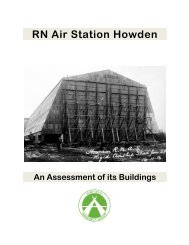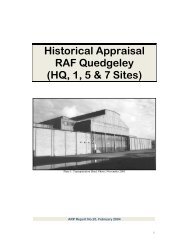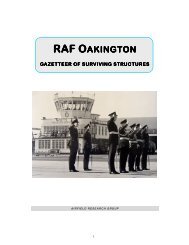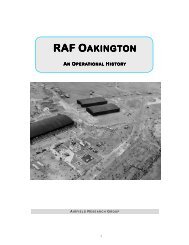RNAS Lee - The Airfield Research Group
RNAS Lee - The Airfield Research Group
RNAS Lee - The Airfield Research Group
You also want an ePaper? Increase the reach of your titles
YUMPU automatically turns print PDFs into web optimized ePapers that Google loves.
<strong>The</strong> number and types of aeroplanes on strength at this time was as follows:<br />
• 24 Short 184 Seaplanes<br />
• 2 Short 827 Seaplanes<br />
• 27 FBA Flying Boats<br />
• 16 Norman Thompson NT2B Flying Boats<br />
By the time of the Armistice in November, the station had grown to its peak strength. Soon<br />
afterwards however, the post-war rundown began and both men and machines were dispersed to<br />
other bases.<br />
2.2 1920 1920-1939<br />
1920 1939<br />
Seaplane training began again in June 1919, but only until December, when it ceased due to the<br />
run-down of the Royal Air Force. After another period of Care and Maintenance, the Air Ministry<br />
finally decided to re-open the station in June 1920, as a permanent RAF station. <strong>Lee</strong>-on-Solent<br />
was initially given the title School of Naval Co-operation & Air Navigation. <strong>The</strong> following year<br />
however, another name change took place, this time as the RAF Seaplane Training School, <strong>Lee</strong>on-Solent<br />
although this was to soon change back to its earlier title (School of Naval Co-operation<br />
& Air Navigation).<br />
From January 1921 and now using Fairey IIID floatplanes, the school’s primary task was to begin<br />
the training of Observers for both RAF and <strong>RNAS</strong> units. Until 1924, seaplane training also<br />
continued on an irregular basis. On 19 April 1923, came yet another title change, this time to the<br />
School of Naval Co-operation. This training establishment remained throughout the period 1923<br />
to 1938 as the station’s principle unit. During 1924, the Fleet Air Arm (FAA) of the Royal Air Force<br />
was formed.<br />
Whilst the bulk of the aircraft moving up and down the slipways during the 1920s, were the Fairey<br />
IIID’s belonging to the school, other machines also made their appearance here during this<br />
period whilst they were engaged in experimental work. Types involved in trials included the<br />
seaplane version of the rugged little Fairey Flycatcher, which was the principal first-line fighter in<br />
use with the FAA until 1934. <strong>The</strong> Fairey machine was also in service with many of the catapult<br />
flights located on the capital ships of the Royal Navy.<br />
Other experiments were conducted with radio-controlled Fairey IID’s and the Parnall Peto, which<br />
was the subject of a remarkable project to provide a submarine with its own aircraft.<br />
During the 1920s and early 1930s, the front-line units of the Fleet Air Arm were the 400 series<br />
Flights, most of which were allocated to aircraft or seaplane carriers. One of the latter was HMS<br />
Vindictive, and for this, 444 (Fleet Reconnaissance) Flight was formed here on 15 January 1925<br />
with three Fairey IIIDs, and eventually sailed for the China Station one year later. More and more<br />
battleships were also being equipped with catapult aircraft at this time and from 1929 onwards,<br />
444 Flight (now returned from overseas) and 445 Flight were amongst the units based at <strong>Lee</strong>-on-<br />
Solent, to supply seaplanes and their crews for cruisers.<br />
During the next six years, major changes took place at <strong>Lee</strong>-on-Solent, which was now being<br />
developed as a major headquarters location.<br />
First of all, in 1930, the School of Naval Co-operation was re-equipped with the much improved<br />
Fairy IIIF, with its long twin floats and in the following year, the school was joined by a new<br />
Floatplane Training Flight.<br />
Secondly, the headquarters of 10 <strong>Group</strong>, which had been based here since 1920 was disbanded<br />
to be replaced by HQ Coastal Area (the forerunner of RAF Coastal Command). This directly led<br />
to a large rebuilding programme of the station’s fabric, with the construction of many grand<br />
buildings that were specially designed to reflect the importance associated with headquarters<br />
Coastal Area. Another major change was the Air Ministry decision to lay out a grass aerodrome<br />
5






